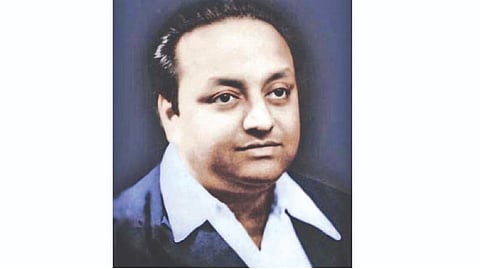

CHENNAI: Though a lawyer by education, K Subramanyam (April 20, 1904 – April 7, 1971) was drawn to cinema. He worked under the legendary PK Raja Sandow in his silent films. As he understood a giant was being born.
When Tamil cinema transitioned to talkies in 1931, there was chaos confusion. Actors spoke in several languages in the first Tamil talkie Kalidas. The market of a film was geographically limited because a silent movie could be exhibited anywhere, whereas a movie with Tamil dialogues was restricted only to the areas where it was spoken.
A few pioneers gave a formal organisation and a direction to move. In spite of the prevailing confusion, KS, like others, was excited by talkie technology which opened up a plethora of opportunities through several filmy aspects which could elevate cinema as a superior medium of entertainment.
But when the nationalist within him realised it could be an effective vehicle for social reform, he started his own production company — Meenakshi Cinetone — named after his wife. Ironically, he met his second wife during the production of this company’s first film.
While early talkies were just photographed versions of a stage play, KS thought differently. He would shoot in grand sets and outdoor scenes. His first talkie was Pavalakodi in which he introduced theatre artistes MK Thyagaraja Bhagavathar and SD Subbulakshmi. The film was a runaway hit that firmly established the careers of all three artistes.
As censorship rules were rigid, most filmmakers centred films on romance or folklore. KS would go on to make four more mythological movies before he dared to break the mould.
Influenced by the prevailing reformist ideals associated with the Congress movement, KS directed a social film that critiqued existing social mores inherited from medieval culture.
In Balayogini (Child Saint) he talked about the plight of widows in middle-class Brahmin communities in Tamil Nadu. Subramanyam’s masterstroke was casting his niece Saroja as the titular character. Baby Saroja was hailed as the Shirley Temple of India. Kanney papa, kanimuthu paapa, rendered by Baby Saroja as a lullaby to her doll, became the state-wide song adopted by mothers to put their child to sleep. The film’s success opened the floodgates for socially themed films in Tamil which gave an impetus to scriptwriters like Anna and Karunanidhi to step into the field within a decade.
By now, Subramanyam had his own banner Madras United Artists Corporation. Subsequently, he made Sevasadan a cinematic adaptation of Premchand’s novel Bazaar-e-Husn, dealing with domestic abuse, prostitution and women’s liberation. To play the heroine, a young girl with a nightingale voice travelled by train from Madurai, which is MS Subbulakshmi, who would one day win the Bharat Ratna for her peerless contribution to music.
In the climax of Sevasadan, the elderly hero, a brahmin contemptuously discards his poonool or ‘sacred thread’, which earlier symbolised his dominance in the caste pyramid. Co-incidentally, the thread-cutting acts that were part of the anti-brahmin agitations by followers of the Dravidian movement started soon after.
His films earned him opposition too. KS produced Bhakta Chetha - a story of a cobbler winning God’s favours through his devotion. Orthodox Hindus petitioned the courts to ban the film. They claimed it was a misrepresentation of Hindu dharma. They were afraid this movie would gather momentum for a prevailing movement in Madurai to permit harijans into the temple for the first time.
Subramanyam also dreamt of a modern studio Madras, as an alternative to Calcutta or Bombay. Forming Motion Pictures Producers Combine (MPPC), a joint stock company, he identified the location for the studio in the corner of Nungambakkam and Mount Road.
MPPC churned out blockbusters. The studio had just completed a film called Inbasagaran when the building burnt down along with the nitrate-based negatives of a fully-shot movie, driving Subramanyam into bankruptcy. Suspiciously three fires that year targeted anti-British organisations.
SS Vasan stepped in, bought the studio and bailed him out. The odd bid of Rs.86,427-11-9led to speculations of numerology, but it was to cover the salary arrears of the unpaid studio’s staff.
Post the bail-out, Subramanyam was never the same. He was active in the 1940s, acting as a hero in one film. But he could not compete with the flood of capital and talent moving in. Though he kept away from production, he was instrumental in instituting several organisations, having realised that cinema was here to stay. South Indian Film Chamber of Commerce, the Nadigar Sangam, the Film Institute, and the Nadaswaram Artists Association owe their founding in whole or part to KS.
Subramanyam introduced a number of eminent artistes like MS Subbulakshmi, MK Thyagaraja Bhagavathar as actors, Papanasam Sivan as composer, the Bharatanatyam trio Lalita, Padmini and Ragini, and DK Pattammal, as a playback singer.
Subramanyam’s family was a cultural melting pot by itself. His first wife Meenakshi, was perhaps Tamil cinema’s first woman lyricist and his second wife was an actress. His daughter Padma Subrahmanyam is an acclaimed Bharatanatyam dancer. The subsequent generations have documentary makers, actors, actresses, choreographers and music directors in plenty.
Are you in Chennai? Then click here to get our newspaper at your doorstep!
Visit news.dtnext.in to explore our interactive epaper!
Download the DT Next app for more exciting features!
Click here for iOS
Click here for Android